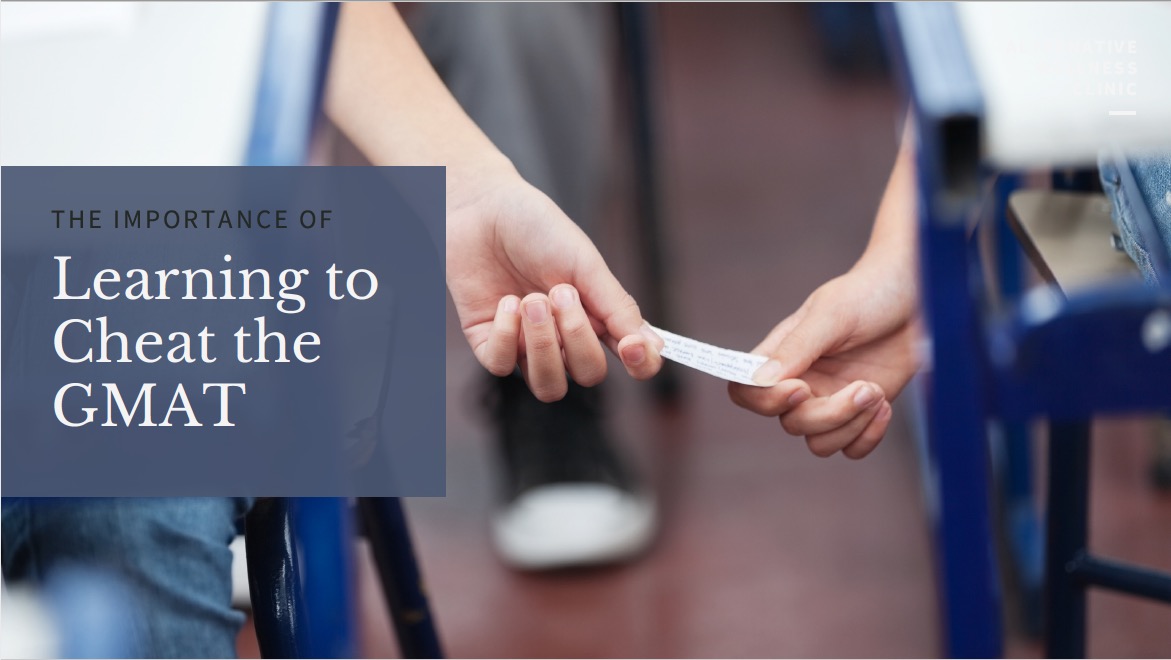What’s the Hardest Part of Studying for The GMAT?
Is it the material – relearning geometrical properties you forgot in high school or wrapping your head around a confusing grammatical rule? Is it knowing how to build a structured study plan that will foresee ahead of time what you should be doing? Is it persistence – sticking to that plan day in and day out? Is it getting yourself to work on the parts of the material that come hardest to you, instead of naturally keeping at the sections you are good at? Is it overcoming the effect of ‘hitting a wall’ – the stage where you’ve got down all the basics, and suddenly your improvement rate slows down considerably?
All of these are challenges. But in our experience as GMAT tutors, we have found that for many people the number one challenge in GMAT preparation is:
Learning that it’s OK to cheat.

Why Cheat?
Of course, we don’t mean actually cheating. What we mean is this: many of us learned to solve problems on exams in school in a straightforward way. You see a question, you use all of the information and arrive at an exact solution, and then you write down the full course that led you from the question’s data to the solution and mark the option that fits.
This is all good and well, but it simply isn’t what the GMAT calls for. In the GMAT, time is a prime issue, and there are many questions that call for quicker but less comprehensive solutions: estimating, using the answers, switching variables with numbers, using logical rules – all to get a quick solution and move on.
Many of instinctively recoil from these kinds of ‘tricks’, and feel as if they are ‘cheating’. As a private tutor, I have often found it curious that getting past this somewhat emotional barrier is often the hardest part for a student who wants to take his GMAT skills to the next level. Many people simply don’t feel comfortable not solving things all the way through, and getting comfortable with that is the hardest (and most important part).
So How To Learn How To ‘Cheat’?
It’s important to first understand on a deeper level what the GMAT is, and what it measures, as it is no ordinary test. The GMAT exam doesn’t measure our knowledge; it measures our “cognitive flexibility”. Therefore, if we wish to excel in the GMAT, it’s essential we work on sharpening this cognitive capability. By breaking down the GMAT experience, we can better understand what “cognitive flexibility” is. GMAT asks us to provide quick answers to unfamiliar questions.
Each question serves up a different twist: it has a distinct difficulty level, uses a unique set of tools, has a different length, tells a different story, can take from a few seconds to a few minutes to solve, etc. But, most importantly, the GMAT presents us with questions that can be solved in many different ways. Unlike our high school teachers, the writers of the GMAT don’t care how we solve each question, but only whether we answer it correctly and how long it takes.
Although the time it takes us to answer a question does not directly influence our score, if we waste too much time, we won’t have enough time for other questions, and our score will suffer. We have to be fast enough and answer correctly if we want to have a chance to solve as many hard questions as we can in the limited time we have (hard questions generate higher scores!). We must be fast AND correct.
The First Rule of Cheating is Knowing When to Cheat
The way to improve cognitive flexibility begins with knowing what tools are available for us to use. Not only rules, formulas, and vocabulary, but also when to avoid certain formulas, identify that no rule can be used, or use logic instead of simplifying difficult equations.
The next step is learning to identify which tools can be used in each question. For example, there can be ten different tools for a particular question, and we usually tend to use the first one that comes to mind (usually the one that is carved into our brain through years of practice and the one that takes longer to implement!).
That is why we shouldn’t go straight to solving questions. Instead, we should start with thinking of all possible solutions to each question and all possible tools that we could use. It is only if we practice the switch among different ways of thinking without any time pressure (in our practice time) that we’ll be able to do it when the clock is ticking. For more details and insights on our method of GMAT preparation, check out our 5 Insight Blog post.
All of this is why examPAL has developed one simple method to find the fastest way to solve each GMAT question. It’s the PAL in examPAL, which stands for Precise, Alternative, or Logical. Prepping with examPAL makes your GMAT preparation process more efficient by helping you find your best solution approach to answering GMAT questions.
So there you have it – we don’t teach you how to cheat on the test. We teach you how to beat it, using the mindset that the test is written to measure.

No Comments. Be the first to post